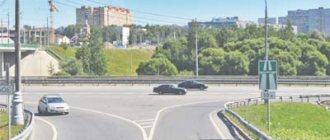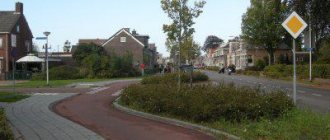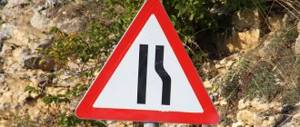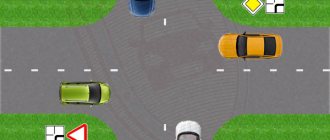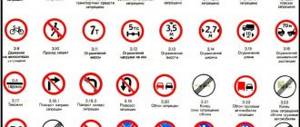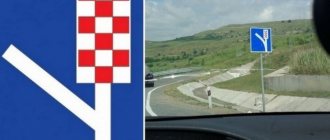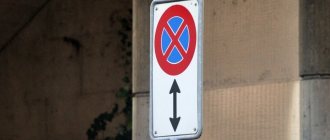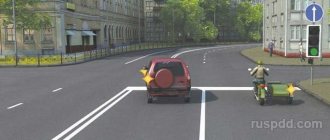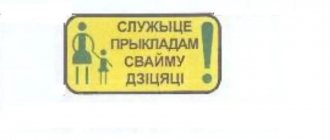Good afternoon, dear reader.
In previous articles in the “Traffic Signs” series, warning road signs were discussed, as well as the features of their use in various situations.
Today we will talk about the second group of road signs - priority signs . This section includes only 13 signs, but they are the ones that determine the order of vehicles in various situations.
The following signs are discussed below:
- the main road;
- end of main road;
- intersection with a secondary road;
- junction of a secondary road;
- give way;
- driving without stopping is prohibited;
- advantage of oncoming traffic;
- advantage over oncoming traffic.
- Fines for violating warning signs.
the main road
The “Main Road” sign designates a road on which vehicles are given the right of way through uncontrolled intersections. Those. Cars on the main road have priority over cars on the secondary road.
If the “Main Road” road sign is installed in front of an intersection without an additional sign, this indicates that the main road passes through the intersection in the direct direction.
Another feature of the main road sign is its coverage area. The road remains the main one until the sign “end of the main road” appears on it. There are no other conditions for canceling this sign in the traffic rules.
Note. Outside populated areas, on roads marked with a main road sign, parking on the roadway is prohibited.
Road sign 2.3.2 “Secondary road junction on the right”
- Traffic Laws
- Traffic signs
- Fines
- traffic police
- Obtaining a driver's license
- Vehicle registration
Traffic signs Priority signs Road sign 2.3.2 “Junior secondary road on the right”
Despite the fact that when driving on the main road, the driver always has the right of way, it is not superfluous to warn him that a secondary road crosses the main road ahead, or that a secondary road adjoins the main one. This function is performed by a series of road signs 2.3 “Intersection with a secondary road”.
This series includes seven signs, each of which indicates its own special case of adjacency or intersection.
Thus, sign 2.3.2 indicates that the secondary road intersects the main one.
The driver has absolutely no need to remember what exactly this or that sign in the series means: the configuration of the intersection is clearly depicted on the sign itself.
In general, the signs of the 2.3 series, in their design, stand out from the series of priority signs and resemble warning signs. Each of them has a triangular shape and a white background with a red border, on which the intersection configuration is schematically depicted in black. And these signs are installed in the same way as warning signs: at a distance of 50 - 100 meters from the intersection within the boundaries of a populated area and at a distance of 150 - 300 meters beyond its border.
The difference in the distance between the sign and the intersection in populated areas and outside them is explained by the fact that higher speeds are allowed on country roads, therefore, the driver needs more time to react and take appropriate measures.
In fact, sign 2.3.2 “Adjunction of a secondary road on the right” performs three functions at once: it warns the driver about a possible danger, informs which side it can be expected from, and indicates the order of his passage.
Most often, road sign 2.3.2 “Junction of a secondary road on the right” is installed outside populated areas, in places where visibility of the intersection is limited.
Having seen sign 2.3.2, the driver must slow down and increase vigilance: the main road is not at all a guarantee that a reckless driver or a person not too familiar with the rules of the road will not be driving on the secondary road at that moment.
Give way
The give way road sign (popularly - give way ) means that at an unregulated intersection you should not interfere with vehicles moving on the main road:
Let me remind you that according to traffic rules, the term give way means that the driver of the car should not start, resume or continue driving if this will force road users who have the right of way to change speed or direction of movement.
At the same time, the give way sign does not require a mandatory stop before the intersection.
Sign 2.1 “Main Road”
Road sign 2.1 “Main Road” indicates a section of the road on which priority is given to travel through unregulated intersections.
This means that any traffic participant who approached an unregulated intersection on the main road has the right to pass through the intersection first in relation to other participants who approached this intersection on a secondary road.
In populated areas, the “Main Road” sign is installed in front of each intersection on the main road. If the intersecting road of an uncontrolled intersection has no more than four lanes, and the main road runs in a straight direction, it is allowed to install sign 2.1 of reduced size.
Intersections are formed with both the intersecting and the adjacent road (T-shaped, U-shaped).
In populated areas, before a secondary road joins the main road, it is allowed not to install the “Main Road” sign on the side opposite the junction. This means that in a populated area, before an intersection with an adjacent secondary road, sign 2.1 can be installed in front of the intersection only on the side of the road junction.
If at an intersection the main road changes its direction, as well as before intersections with a complex layout, the “Main Road” sign is used with plate 8.13 “Direction of the Main Road”. Sign 8.13 shows a schematic diagram of the intersection. The thick line symbolizes the main road, thin lines represent secondary roads.
When the main road at an intersection turns and you need to turn, you need to remember the requirement of paragraph 8.5 of the traffic rules - take a position on the roadway corresponding to the direction of the turn. For more information about the rules for turning at such intersections, see the article Exiting and turning from the main road.
If you are driving through an intersection in the forward direction, at which the main road turns right (exit onto a secondary road), you must remember the requirement of paragraph 13.10 of the traffic rules - to give way to vehicles that are turning towards you on the main road. This traffic situation is discussed in the article If the traffic light at an intersection does not work.
In populated areas, sign 2.1 with plate 8.13 is installed in front of the intersection, and outside populated areas - first at a distance of 150 - 300 meters before the intersection and in front of the intersection.
In the case where an intersection has several crossings of roadways, the “Main Road” sign is installed in front of all intersections at which there may be an ambiguous determination of the primacy of roads.
At controlled intersections, sign 2.1 “Main Road” is placed in close proximity to the main traffic light, usually on its support. A traffic light operating in the “red-yellow-green” mode cancels the priority signs.
The rules for driving through an unequal intersection, in particular, driving along the main road, including answers to some questions from readers, are set out in the Main Road series of articles.
Driving without stopping is prohibited
The no-stop sign is a “strengthened” version of the give way sign:
It differs from the previous sign in that the driver must stop before the stop line or the edge of the roadway being crossed.
In addition to intersections, the sign can also be installed in front of railway crossings. In this case, the driver should stop in front of the stop line, and if there is no stop line, in front of the sign itself.
As a rule, the sign “driving without stopping is prohibited” is installed before intersections with limited visibility, where a large number of traffic accidents occur, so it should not be ignored in any case.
List of priority signs with descriptions for 2021
Signs that determine the priority of drivers on the roads are established by the Government of the Russian Federation (Resolution No. 1090 of October 23, 1993), and are numbered in accordance with GOST R 52289-2004. Let's look at a detailed description of each.
the main road
Tells the motorist about entering an uncontrolled intersection where he has the right of way. It applies to the entire length of the intersection or intersection.
When following the sign, remember that there is more than one entrance in the area regulated by this sign. When two cars pass, the advantage is determined by the obstacle on the right. This means that you need to yield to vehicles located on the right hand side of the driver. Often the designation is combined with a complementary sign indicating the direction of the road if it changes.
End of the main road
Based on the name, it is not difficult to determine the meaning of the sign: it indicates the termination of the motorist’s right of priority passage, which he enjoyed in previous sections. Without installing other designations, it defines the intersection as equivalent. Therefore, the driver determines the right of way using the “right hand” rule.
Most often, the sign indicating the end of the main road is combined with a “Give Way” or “STOP” sign. With such combinations, the intersection must be regarded as unequal.
It is allowed to place it a few meters from the intersection, as well as duplicate it directly in front of it.
Intersection with a secondary road, junction of a secondary road
A rather large subgroup of signs are usually located outside populated areas.
They show that the driver is moving along the main lane (it is indicated in bold), and shows on which side the secondary roads adjoin it or cross it. The appearance of these signs is very similar to warnings. This is due to the coincidence of the rules for their location - 150–300 meters before the intersection outside the city and 50–100 meters within the populated area.
Give way
Calls for priority to be given to those traveling on the main road. When changing its direction at an intersection, the sign is supplemented with a special sign. It can be installed at exit points from areas bordering the road, when motorists cannot independently determine the advantage.
Driving without stopping is prohibited
A unique octagon-shaped indicator, the color and shape of which prevents it from being confused with others. It indicates the obligation to let cars passing on the main road and at the same time stop for a short time. If there is no traffic on the main road, you still need to stop.
When "STOP" is applied:
- Before intersections with poor visibility.
- Before moving railway transport, which is not regulated in any way.
A sign requiring a mandatory stop of the car allows you to fully assess the situation and take timely measures to avoid an accident.
You must park in front of the stop line, and if there is no such sign, in front of the edge of the road. On railway tracks, if there is no line, you need to stop right in front of the sign.
So, “STOP” says that you need to make two maneuvers - give way and stop at the same time to assess the situation, regardless of whether there are passing cars on the main road.
Advantage of oncoming traffic, advantage of oncoming traffic
Signs with similar names, but with completely opposite meanings. The first carries a requirement to give way, and the second communicates priority. These designations are used only for narrow roads where entering the oncoming lane is difficult due to some circumstances.
The first sign requires you to give way to oncoming motorists. It is similar in form to prohibitive. The second one establishes an advantage over oncoming traffic and gives the motorist the right to pass first.
The advantage of oncoming traffic
Unlike the signs discussed above, which are most often installed in front of intersections, the oncoming traffic priority sign is installed on narrow sections of roads where oncoming traffic is difficult:
An oncoming traffic right-of-way sign tells the driver that he must give way to oncoming traffic on a narrow stretch of road. This sign is usually installed at road work sites and on narrow bridges.
Sign 2.2 “End of the main road”
The "End of Main Road" road sign indicates that the road on which priority has been granted for uncontrolled intersections has ended. Sign 2.2 is installed at the end of the road section where it loses its main status.
If the main road ends before an intersection, then sign 2.2 “End of the main road” is placed:
- in populated areas - either together with sign 2.4 “Give way” or 2.5 “Driving without stopping is prohibited”, or 25 meters from the intersection; a preliminary sign 2.2 with a plate 8.1.1 “Distance to object” may be installed.
- outside populated areas - on the same support with a preliminary sign 2.4 “Give way”, which is installed with a sign 8.1.1 or 8.1.2 “Distance to the object”; sign 2.2 can be re-installed with sign 2.4 or 2.5.

